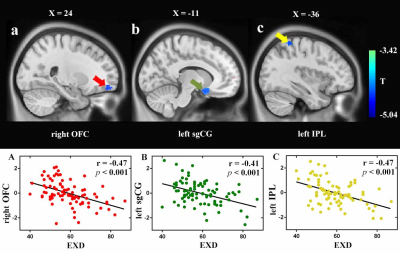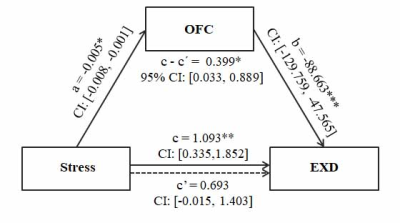2146
Regional Gray Matter Volume Associated with Exercise Dependence: A Voxel-Based Morphometry Study1Sichuan University, Chengdu, China, 2Huaxi MR Research Center (HMRRC), Department of Radiology, West China Hospital of Sichuan University, Chengdu 610041, China, ChengDu, China
Synopsis
The present study provides initial evidence indicating that a higher risk of EXD is linked with a smaller GMV in the right OFC, left sgCG, and left IPL in a sample of regular exercisers, which sheds light on the neuroanatomical basis of EXD. Furthermore, our study found that the right OFC mediates the relationship between stress and EXD, revealing a potential neuropsychological mechanism for how stress affects EXD. Our findings might facilitate the diagnosis of EXD and the target selection for the corresponding intervention (e.g., behavioral or brain intervention ) to help individuals reduce EXD and improve their quality of life.
Background
Although regular physical exercise has multiple positive benefits for the general population, excessive exercise may lead to exercise dependence (EXD), which is harmful to one’s physical and mental health. Increasing evidence has suggested that stress is a potential risk factor for the onset and development of EXD.Purpose
We aimed to identify the neural substrates of EXD and the underlying neuropsychological mechanism by which stress affects EXD.Study Design
Cross-sectional study. A voxel-based morphometry method based on structural magnetic resonance imaging was used to study cortical gray matter volume (GMV) alteration in regular exercised participants.Methods
A total of 86 individuals who exercise regularly were recruited (46 males, age range 18 to 41 years). Self-reported exercise dependence scale, depression, anxiety, and stress scale, and socio-demographics were evaluated. Herein, we investigated these issues by whole-brain correlation analyses and prediction analyses.Results
Whole-brain correlation analyses and prediction analyses showed negative relationships between EXD and GMV in the right orbitofrontal cortex (OFC, r = -0.49, p < 0.001), left subgenual cingulate gyrus (sgCG, r = -0.43, p < 0.001) and left inferior parietal lobe (IPL, r = -0.49, p < 0.001). Furthermore, mediation analyses showed that the GMV of the right OFC was an important mediator between stress and EXD. Importantly, these results persisted even when adjusting for sex, age, body mass index, family socioeconomic status, general intelligence and total intracranial volume, as well as depression and anxiety.Conclusion
The present study provides initial evidence indicating that a higher risk of EXD is linked with a smaller GMV in the right OFC, left sgCG, and left IPL in a sample of regular exercisers, which sheds light on the neuroanatomical basis of EXD. Furthermore, our study found that the right OFC mediates the relationship between stress and EXD, revealing a potential neuropsychological mechanism for how stress affects EXD. Our findings might facilitate the diagnosis of EXD and the target selection for the corresponding intervention (e.g., behavioral intervention 1, brain intervention or training programs 2-5) to help individuals reduce EXD and improve their quality of life.Acknowledgements
This study was supported by the National Natural Science Foundation of China (Grant Nos. 31800963, 81971595, 81771812, 81820108018 and 81621003), Program for Changjiang Scholars and Innovative Research Team in University (PCSIRT, Grant No. IRT16R52), the Science and Technology Department of Sichuan Province (2018SZ0391), the Innovation Spark Project of Sichuan University (No. 2019SCUH0003), the China Postdoctoral Science Foundation (Grant No. 2019M653421), and the Postdoctoral Interdisciplinary Research Project of Sichuan University.References
1. Lichtenstein MB, Nielsen RO, Gudex C, Hinze CJ, Jørgensen U. Exercise addiction is associated with emotional distress in injured and non-injured regular exercisers. Addictive behaviors reports. Dec 2018;8:33-39.
2. Esch T, Stefano GB. Endogenous reward mechanisms and their importance in stress reduction, exercise and the brain. Archives of medical science : AMS. Jun 30 2010;6(3):447-455.
3. Tuulari JJ, Tuominen L, Arponen E, et al. Aerobic exercise modulates anticipatory reward processing via the μ-opioid receptor system. Hum Brain Mapp. Oct 2018;39(10):3972-3983.
4. Fontes EB, Bortolotti H, Grandjean da Costa K, et al. Modulation of cortical and subcortical brain areas at low and high exercise intensities. British journal of sports medicine. Jan 2020;54(2):110-115.
5. Boecker H, Sprenger T, Spilker ME, et al. The runner's high: opioidergic mechanisms in the human brain. Cerebral cortex (New York, N.Y. : 1991). Nov 2008;18(11):2523-2531.
Figures


The GMV of the right OFC mediates the association between stress and EXD. The illustration demonstrates that stress affects the EXD though the GMV of the right OFC. Sex, age, BMI, general intelligence, family SES and TIV were controlled in the model.
* p < 0.05; ** p < 0.01; *** p < 0.001